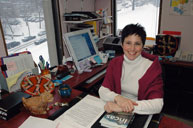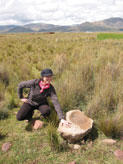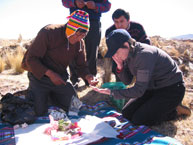Beneath Bolivia: Digging for city life in the ancient world
Beneath Bolivia: Digging for city life in the ancient world McGill University
User Tools (skip):
Beneath Bolivia
Digging for city life in the ancient world
While most McGill researchers work in their offices, Nicole Couture, a recent recipient of the Canada Research Chair in Anthropology of Early Urbanization, does her research in far-flung Bolivia. She goes to a windswept and remote area of the country where she interacts with indigenous communities and assists with their offerings to the gods. Her aim is to understand the urban history of an ancient city that time has buried underground.

Anthropologist Nicole Couture in her office at McGill.
Robin Edgar
The focus of her research is the city of Tiwanaku, built by ancestors of the Aymara people over 1,500 years ago and one of the largest in the pre-Incan world with a population of between 15,000 and 20,000 inhabitants. Tiwanaku, a cold and challenging environment to work in, is located at an elevation of 3,800 metres in a valley of the Andes near the frigid waters of Lake Titicaca. Around the 11th or 12th century, the city fell into decline due to a long and severe drought that lowered water levels in the lake and destroyed Tiwanaku's agricultural system. Over time, the abandoned adobe buildings eroded and the sediment buried much of the ruined city. These ruins provide Couture with information about cities and city-life in the ancient world. She is interested in how urban spaces have been used throughout the centuries. For example, she wants to define the walled neighbourhoods of Tiwanaku because people worked within these walls. However, this and other research questions can be addressed only when the Aymara people allow her team to conduct their research.
Couture's team includes researchers from the Field Museum of Natural History in Chicago, the Bolivian National Institute of Archaeology and the University of Vermont, as well as local Aymarans, the modern descendents of Tiwanaku's city dwellers. Aymarans have a rich culture that focuses on "Pachamama" or Mother Earth, and, as guardians of their land, they demand that before research begins the gods must be given offerings. Another important member of her team is the local ritual specialist or "llatiri" who assists with the ceremonies. "The llatiri oversees these complex rituals that involve presenting items to the gods including coca leaves and a fresh llama fetus for the renewal of Pachamama. This is done while pouring liberal amounts of liquor into the ground and over the geophysical equipment," Couture explained. Once this tribute is complete, she proceeds with her own preparatory rituals.

In the unexplored section of the site of the pre-Incan city of Tiwanaku in Bolivia.
Courtesy of Nicole Couture
Because the geophysical equipment requires plowed soil, the first step is to prepare the ground. Her team pulls out tufts of rough grass by hand and with picks; the plowing is done by oxen. However, negotiating for oxen in the developing world is a skill that takes years to hone and even then outcomes can be unpredictable. The oxen are obtained locally after extensive bargaining over wages, number of oxen, and work hours. "We asked, paid for, and were promised six teams of oxen, but only one team arrived for the plowing" said Couture, "this made things move along slowly." Once the ground is plowed, Couture's team maps the underground features and infrastructure of the city. For example, she uses a magnetometer to collect data to locate stone blocks, in particular stone wall foundations in the survey area. Maps created from these geophysical data are used as blueprints to define targets such as neighbourhoods, where her team eventually digs.
Couture has recently returned from two and a half months of exciting research at Tiwanaku. "We opened six areas for excavation to test the geophysical maps. These maps helped us locate a cluster of three prepared tombs cut in sterile soil nearly one metre below the surface. The tombs held the remains of young children, one of whom was accompanied by an intact ceramic goblet." Although finding tombs is a rare occurrence, it was not the only discovery this past summer. Her team also found what appear to be the remains of a large building far from the city's centre. According to Couture, "the fine stonework suggests that this feature belongs to a rather special structure that is over a half a kilometre from the site's central ceremonial district." She suspects that these stones are part of a monument or a temple but this theory will not be tested without further excavations, which will take place in 2006.

Setting up ceremonial offerings for the gods.
Courtesy of Nicole Couture
Before you quit your desk job to become an archaeologist like Couture, think of the challenges she faces. Travels in far-off lands to study ancient ruins sound like an attractive alternative to office-based research but it's not easy. Couture works up to four months a year in cold camps at high altitudes in the developing world. If this doesn't deter you and if you are up for adventure, being an archeologist could be a dream profession.
WARM-SPARK (Writing About Research at McGill-Students Promoting Awareness of Research Knowledge) is a program supported by the VP Research Office, Associate Vice Principal (Communications), the faculties of Agricultural and Environmental Sciences, Arts, Engineering, Medicine, and Science. See www.spark.mcgill.ca.

